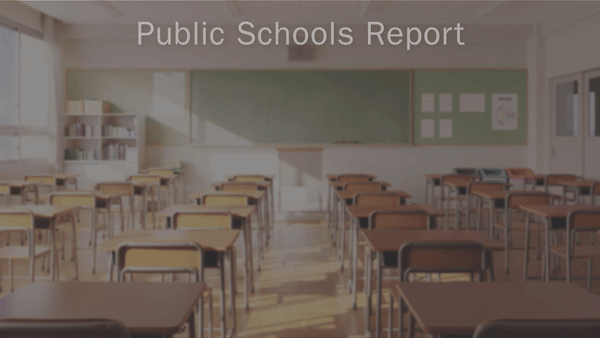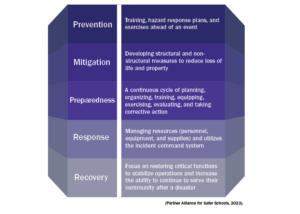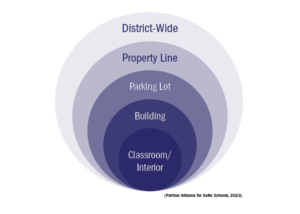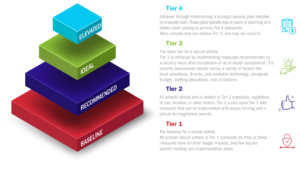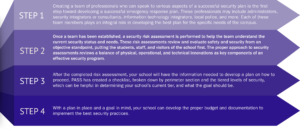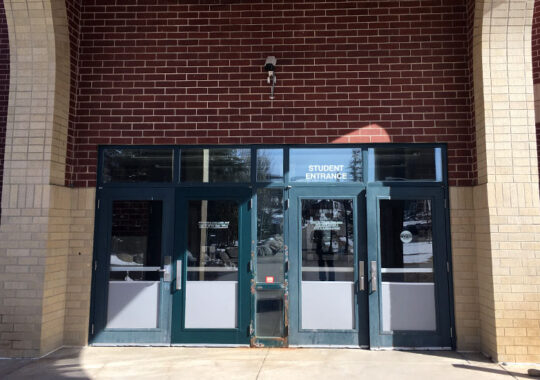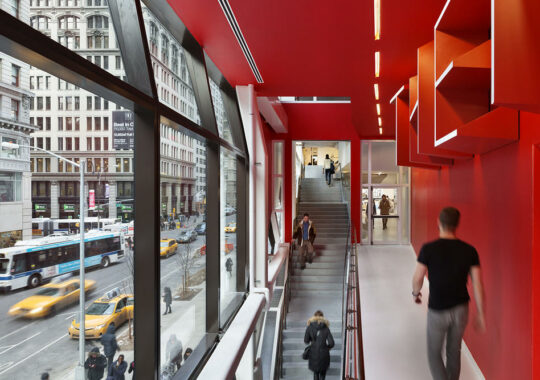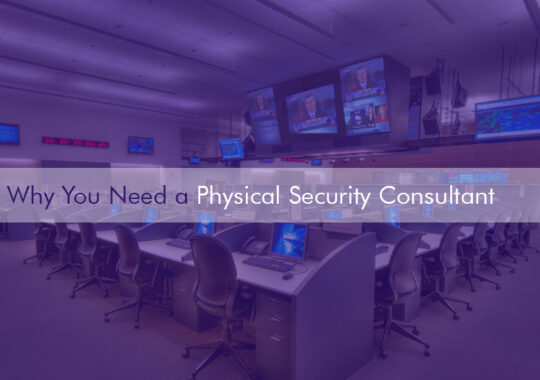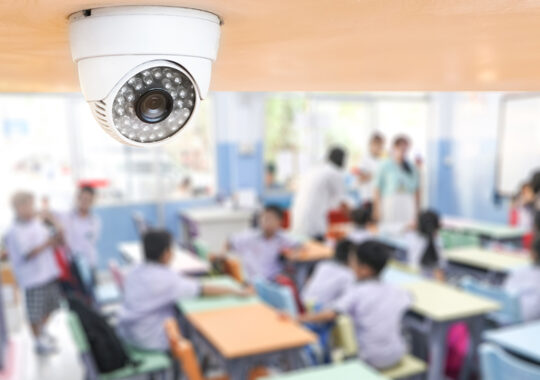Learning and teaching are important elements of our culture and communities. K-12 schools and higher education institutions alike provide community resources for public gatherings (e.g., concert venues, polling stations, meeting spaces, and sporting venues), not to mention their inherent function of educating children and adults (at various times of day and night). With so many of us impacted by educational institutions, protecting these community assets and the loved ones we send there from the various threats they face is crucial.
Given the increased occurrence of incidents at schools, it is important to prioritize security and safety now more than ever. We want our loved ones to be safe always, which means entrusting our school administrations to protect them each day so they can return home safely. School safety and security challenges today are extremely complex and go beyond obvious physical security elements. Just as important as cameras and doors are the proper policies, operations, technologies, mental health awareness, and support schools need to keep their campuses secure. Recent years have brought various types of incidents to school campuses, some of which were tragically violent, from which many schools have learned, adapted, and improved their security plans and strategies to encompass the range of incidents that can take place in a school. Schools must analyze these tragedies to learn from them by understanding the details of the event that took place, warning signs, and how the campus was breached.
As important as it is to react to incidents appropriately, it is critical that schools are prepared with emergency response plans and training in place for a variety of possibilities. Thankfully, there are a number of resources available, created by organizations like the Partner Alliance for Safer Schools and others, to help guide schools on the methods to keep campuses secure and safe. Following is an overview of the resources available to school systems as they work to achieve a higher level of preparedness for the diverse scenarios that take place in schools at all learning levels across our nation and the globe.
The PASSK12 Safety & Security Guidelines
Preparedness is essential for recognizing the optimal response to and recovering from any security breach or emergency. Understanding the importance of preparedness, The Partner Alliance for Safer Schools (PASS) organization has created the Safety and Security Guidelines for K-12 Schools.
“The PASS Guidelines were developed to provide administrators with a means to effectively evaluate security infrastructure currently in place, prioritize investments, and maximize security gained by leveraging available resources.” (Partner Alliance for Safer Schools, 2023).
Within these guidelines, PASS outlines five phases of emergency management: prevention, mitigation, preparedness, response, and recovery. Following is a summary of the PASS approach. Additional information can be found within the detailed guidelines.
A Layered Approach to a Secure Perimeter
When implementing a plan to keep a school secure, the U.S. Department of Homeland Security recommends a layered approach.
“A layered approach is essential to addressing a broad range of threats, as each successive layer provides specific components to deter, detect, and respond to adversarial behaviors in the event that other layers are bypassed or breached.” (Partner Alliance for Safer Schools, 2023).
PASS recommends five physical layers for school facilities, each with its own tiered safety and security components.
District/Campus-Wide Perimeter
Coordination at the district/campus level is critical to the success of school safety procedures at every other layer. The district/campus can develop and adopt policies that are integrated at each school. This includes processes, plans, technologies, and procedures and helps ensure these measures are updated, evolving, and consistent. This perimeter can be applied to colleges and universities by becoming a university-wide perimeter. (Partner Alliance for Safer Schools, 2023).
Property Perimeter
A school’s property begins at the school’s boundary and extends to the parking lot and property perimeter. This area may include playgrounds, sporting fields, and other facilities that are often used by the public when school is not in session. This area is especially important as it is where the most visible security deterrents to a threat can be located. (Partner Alliance for Safer Schools, 2023).
Parking Lot Perimeter
The parking lot perimeter is especially critical, as this is where students, staff, and visitors park their vehicles or arrive by bus or other means. It is common for this area to have the most safety issues. This includes falls, car accidents, dangerous driving, theft, vandalism, assault, and more. (Partner Alliance for Safer Schools, 2023).
Building Perimeter
The building perimeter begins at the school’s exterior envelope and includes the perimeter of the building itself, along with exterior doors and windows. This perimeter is very important, as it is the direct means of entrance to the school building. (Partner Alliance for Safer Schools, 2023).
Classroom/Interior Perimeter
The classroom/interior perimeter includes the entire interior of the school. This includes classrooms, gymnasiums, cafeterias, media centers, and more. This is the most critical layer to protecting the students, staff, and visitors, as it is the last layer of defense against external threats and the first layer of defense against internal threats. (Partner Alliance for Safer Schools, 2023).
A Tiered Approach to Securing a Campus
Each layer of facilities has its own tiered safety and security components to help a school ensure each area is secure. This tiered approach lays out the best practices to accomplish a certain level of security within a perimeter, broken out by various components such as policies and procedures, people, communication, access control, and more. PASS recommends that a school progress from a Tier One facility to a Tier Four facility to provide the best secure environment for their students, staff, and visitors.
The primary purpose of these tiers is to help administrators in a school or campus evaluate their risk levels, identify their security needs, and properly evaluate and allocate their available resources. In this way, they are able to develop a security plan specific to their school, district, or campus needs, utilizing proven practices and procedures created by experts.
PASS was able to create these guidelines by relying on its partners, which represent various industry sectors and other nonprofit organizations that share the same vision, and support the tools, resources, and mission of PASS. One of these nonprofit partners is ASIS International, the largest professional organization for security management professionals, founded in 1955. ASIS International is a supporter of the PASS safety and security guidelines and echoes the importance of these guidelines. ASIS International is currently working on its own school security standard, which the organization hopes to have implemented as a standard across the U.S. for all schools.
The ASIS International School Security Standard
“ASIS International, in its role as a Standards Developing Organization (SDO), develops standards and guidelines to serve the needs of security practitioners in today’s global environment. Through these roles and the expertise and knowledge of its members and the industry at large, ASIS plays a pivotal role to influence and impact security standards worldwide.”
Sue Carioti, Vice President, Certification, Standards and Guidelines, ASIS International.
ASIS International is an organization for security professionals that issues certifications, develops standards and guidelines for the security profession globally, and provides its members with year-round learning and networking opportunities. ASIS International has a network of 34,000+ members across the globe, with more than 40 security professionals comprising the ASIS School Security Technical Committee. Bringing together the value of diverse backgrounds, members are working to develop a school security standard that will focus on preparedness, not response. Preparedness measures are crucial for schools or districts to take the necessary precautions to prevent and/or mitigate assorted forms of school violence and other related incidents and work in conjunction with various developed or to-be-developed emergency response plans. Within this committee, there are three annex groups that focus on a specific section of the standard: physical security, emergency operations planning, and behavior threat management.
Currently, there is no nationally recognized school safety standard, only a small number of procedural safety measures. Some jurisdictions have existing laws and mandates in their own state, but this inconsistency means some schools are left with no guidelines for minimum safety measures. ASIS International hopes to change this. David Goetz, SM&W’s Integrated Communications Technology Manager, is a member of both the ASIS School Security Technical Committee and the physical security annex group. David is very passionate about ASIS International, explaining, “I am thrilled to be the 2024 Chair of the ASIS School Safety and Security Community. ASIS is a recognized leader globally in the security realm, so it’s a great privilege to be in this leadership role within the ASIS organization.” ASIS and the entire Security community are very passionate about the security standards being drafted due to their relevance and importance in today’s society. Every day we send our loved ones to school as students, teachers, school resource officers, or staff, assuming and expecting that they will return safely to us at the end of the day. Given unfortunate recent events happening in our schools, ASIS and its members are working diligently to create a standard that can be used in a preventative manner to help better protect our children, loved ones, and schools. “Personally, as a father, security subject matter expert, and former educator, I want to do all I can to help protect our children and make schools the safe and secure environments that they should be,” says Goetz. ASIS International’s forthcoming standard will be an important element in providing K-12 schools with a blueprint for implementing security protocols based on real-world security threats.
Considering the rise in incidents on school grounds, administrators should utilize available resources to prepare themselves on how to respond and recover from any security breach or emergency possibilities. Every school is unique in its needs, and organizations such as PASS and ASIS help schools evaluate their needs, determine the best practices unique to their own situation, and implement a plan successfully.
How to Prepare Your School
It is imperative that educational institutions are equipped with preparedness guidelines and emergency response plans that cover a wide range of scenarios. There are many ways to prepare your school, and each resource recommends different approaches to achieve the same goal: implementing a security plan and process that secures your school and keeps everyone safe.
Review, Revise, and Reimplement
Keeping our loved ones safe is the utmost priority, and schools should be one of their most safe and secure environments. Unfortunately, schools face new, complex challenges every year, with constant budget challenges. Being prepared with a plan is essential to mitigating threats and recovering from any security breach or emergency. However, being prepared goes beyond creating and implementing a security plan. The most crucial part of keeping your school secure long-term is updating the processes in place to understand the current threats and respond accordingly. Just like our communities and schools, the security industry is constantly changing and evolving, and with this evolution comes the need to update best practices for safety and security. Schools need to regularly review and revise their plans, ultimately reimplementing the newest practices to utilize the most up-to-date resources, approaches, plans, processes, documentation, technologies, and more.
